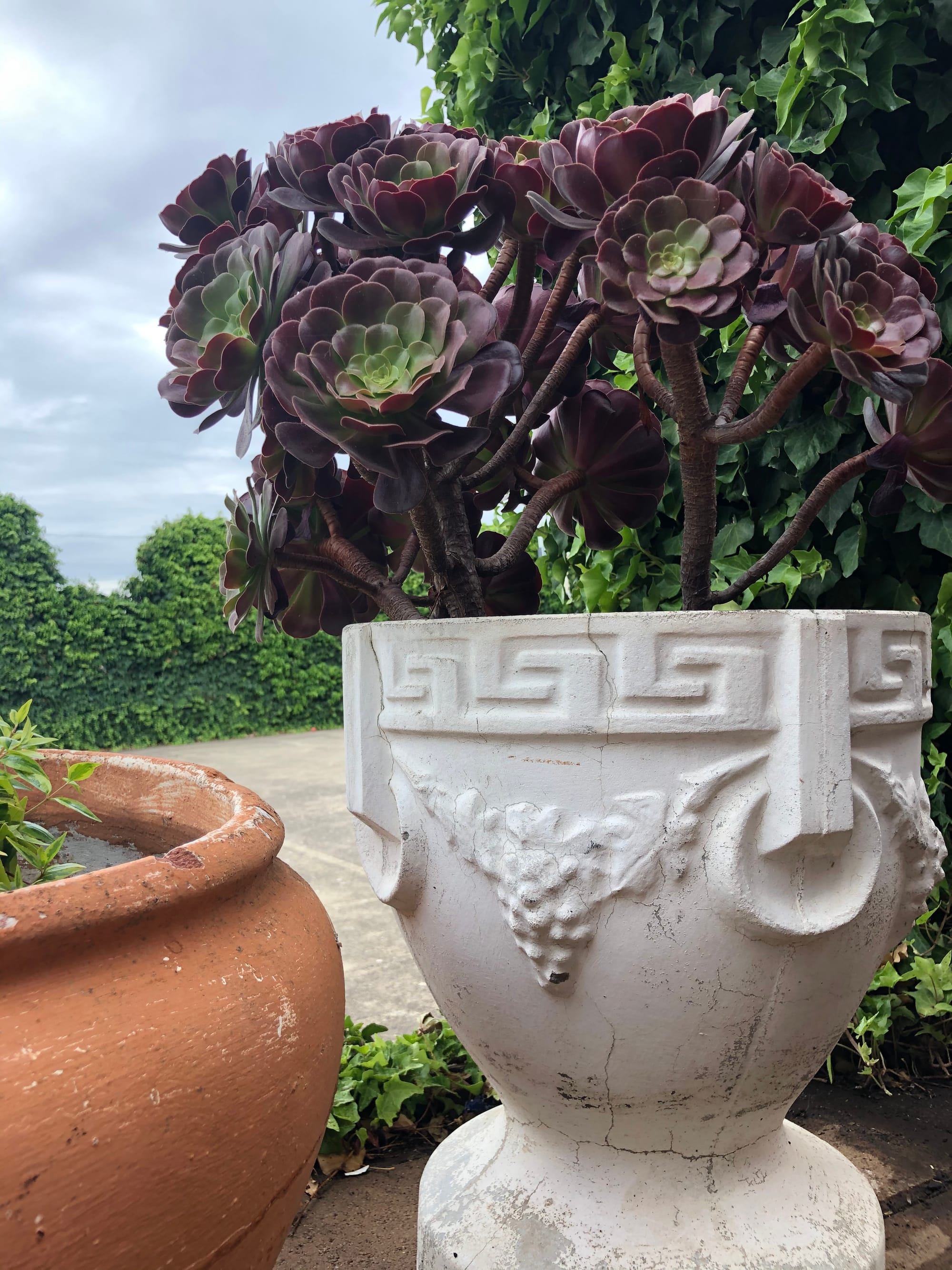
Aeonium arboreum 'Atropurpureum'
Contents
- Top Tips
- Location, Water, Humidity & Fertilisation
- Common Issues
- Origins, Temperature, Propagation, Repotting & Toxicity
Need the answer to a specific plant query? Book a 1-to-1 video call with Joe Bagley, the website's friendly author, to overcome and address your niggling problem! Available on iMessage, WhatsApp, Facebook Messenger & more.
Top Tips & Info
- Care Difficulty - Easy
- Aeoniums (pronounced Ay-OWN-ee-um) will require a bright location with several hours of direct sun per day. It's best to situate yours in an area like a conservatory, warm porch or a windowsill, or somewhere that promotes profitable, healthy growth.
- Although Aeoniums aren't frost-hardy, they can deal with temperatures of around 5º - 35℃ (40º - 95℉), so all year round in a conservatory is ideal.
- Aeoniums must endure periods of droughts in between waters - if you're stuck with when to water it, think of the ukhouseplants' phrase of 'Drenches Between Droughts'.
- Fertilise using a 'Houseplant' or 'Cactus' labelled feed every three to four months throughout the year.
- Repot every three to four years during the spring, using a 'Cactus & Succulent' potting mix. This is the perfect time to propagate the stems that'll root quicker during this period.
- Don't worry about a hardened/woody stem or crispy brown older leaves. Both of these 'symptoms' are a normal part of Aeonium maturity! (See Image 2 for an example). They'll also go through a dormancy during the spring and summer, so don't expect much leaf growth during these warmer months!
Location & Light - 🔸🔸🔸
A few hours of direct sunlight is a must; shady locations could lead to diseases associated with over-watering. The frequencies of irrigations solely rely on the amount of the sun received. If the Aeonium develops a discoloured white crown, this is typically down to too little light. Newly-propagated stem cuttings must not receive any sunlight as their insufficient root systems will not soak up enough moisture to survive the harsh rays.
We'd recommend placing yours in a windowsill, conservatory or within two metres of a south-facing window. Aeoniums can be placed outdoors once the risk of frost has elapsed, until the following autumn.
Water - 🔸
If you're confused about when to water your plant, remember the phrase 'drenches between droughts'. It's far better to keep the specimen dehydrated than it is to drown it. Winterising your Aeonium is also essential to maintain good health; keep the plant 'ticking over' by reducing the number of irrigations to every three weeks and avoid over-fertilisation. One word of advice is never to allow excess moisture to settle either in the actual crown of the plant or underneath the pot, as both will cause southern blight or even black rot. Under-watering symptoms include drooping leaves, stunted growth, and drying leaves - these can be a range of different issues, including forgetfulness, too much sunlight, or the plant being pot-bound. Over-watering symptoms include root rot, a rotting base, or sudden plant death. Aeonium must have sufficient light levels (at least two hours of direct sunlight a day) to counteract the chance of root rot and over-watering. For severe cases, take several stem cuttings on the leading growths that aren't soft at the base. Scroll down to 'Propagation' for more information.
Humidity -
This is not a factor; however, if the Aeonium is situated indoors, a quick hose down from time to time will reduce the number of dust particles covering its leaves.
Fertilisation - 🔸
Whilst using a diluted concentrate fertiliser, feed every three to four months throughout the year. Although a 'Houseplant' fertiliser will still do the job, we'd recommend using a specific 'Cactus' labelled feed as it'll support the vital seventeen nutrients that this species will need to grow, along with the added bonus of potential flowers in the spring or summer!
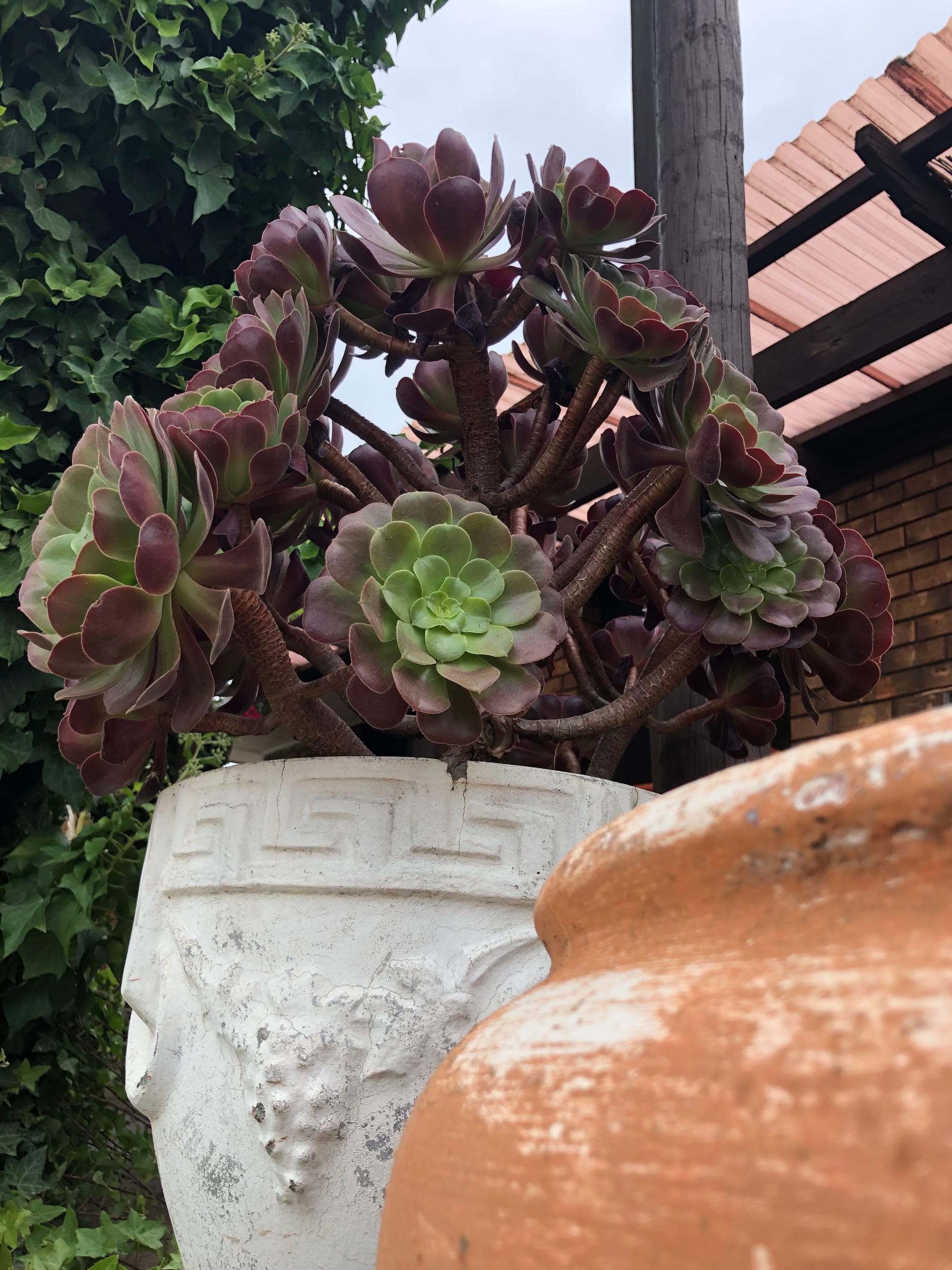 Aeoniums will do very well when placed outdoors from late spring onwards. Once the risk of frost returns (autumn onwards), relocate the specimen into a sun-filled location of the house with minimal watering to reinforce its dormancy. The lowest temperatures they can survive in is around 5℃ (40℉).
Aeoniums will do very well when placed outdoors from late spring onwards. Once the risk of frost returns (autumn onwards), relocate the specimen into a sun-filled location of the house with minimal watering to reinforce its dormancy. The lowest temperatures they can survive in is around 5℃ (40℉).
Common Issues with Aeoniums
Aeoniums may die after flowering. One way around this natural behaviour is by taking 10cm stem cuttings once a year from the 'leading growths' (i.e. the tallest stems). Root the cuttings in water and place into a 7cm pot of soil once the roots are 5cm in length. (More information on cuttings in the 'Propagation' section towards the end of this article).
If your Aeonium isn't growing during the spring or summer, this is because it naturally goes into a dormancy period during the warmer weather. Even if the older leaves become crispy and brown, the plant will be fine as long as it's kept on a sunny windowsill. New growth typically will develop once the autumn kicks in, shortly after its summer flowers drop off.
Over-watering is the most common issue, with typical signs including a softened yellow stem and stunted growth. There must be periods of droughts to replicate the habitats of the east African deserts, as well as limiting the chance of diseases. Avoid waterlogging as there's no point fulfilling the phrase 'drenches between droughts' if the base of the pot is submerged. For more information about over-watering related issues, be sure to click on this link.
A pale centre and deformed growth are typical signs of too little light. Offer at least an hour of direct sunlight, especially in the winter months, to provide the vital nutrients that'll be converted into plant sugars.
Scorched or browned edges are the result of too little water and over-exposure to the sun. Although Aeoniums are a superb choice for plants in sunny locations, those that haven't acclimatised to the harsh rays will show signs of sun-scorch and environmental shock. Prolonged exposure will significantly speed the process of dehydration, so consider transplantation into a bigger pot (in the spring) to wrap the roots around moister soil.
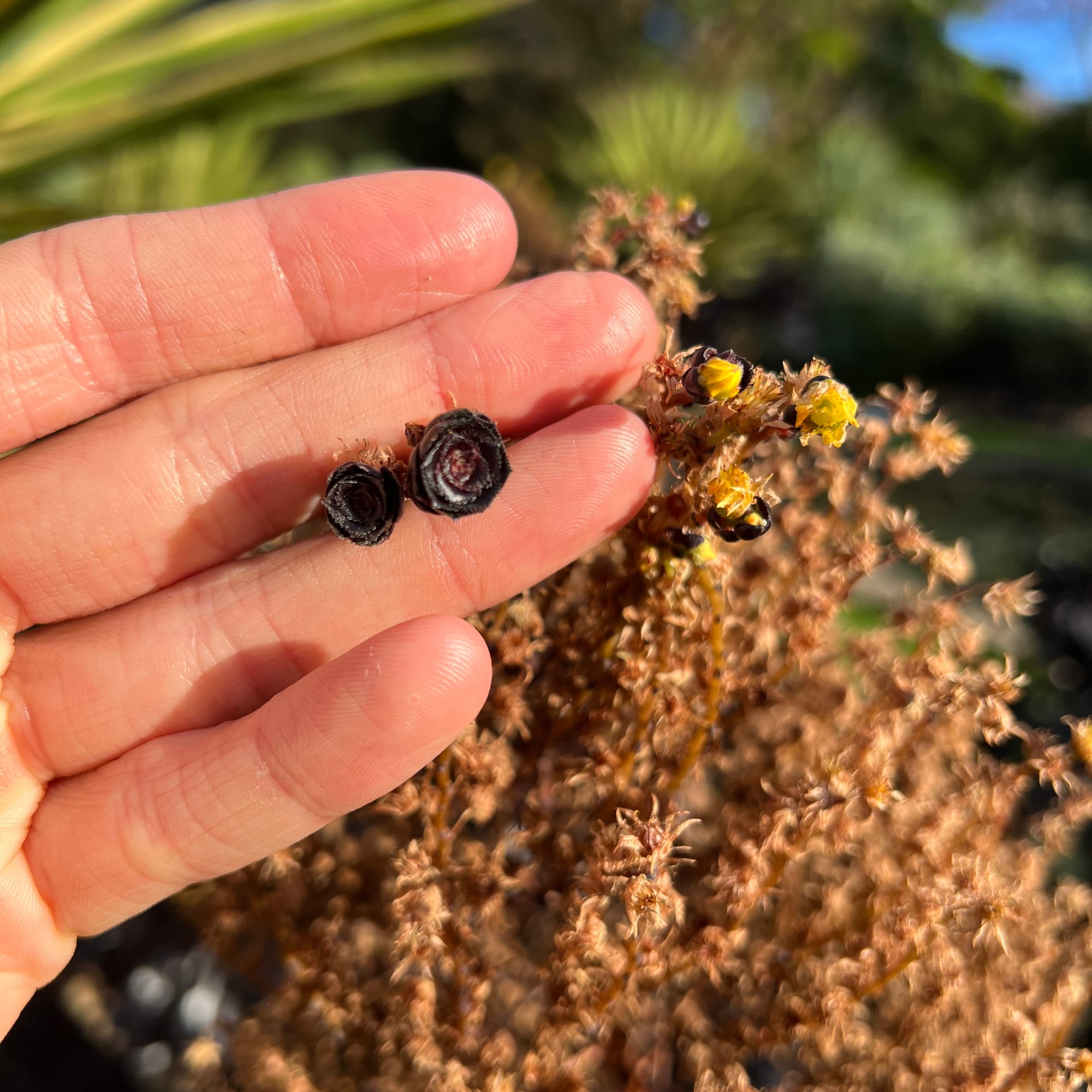 In rare occasions, the flower spike may develop a small rosette cluster of foliage that can also be propagated as a stem cutting.
In rare occasions, the flower spike may develop a small rosette cluster of foliage that can also be propagated as a stem cutting.
Over-feeding an Aeonium will bring nothing but grief in the likes of yellowing leaves and weak, dramatic growth. Although fertilisation is an excellent way to promote good health, dry soil and fertiliser salts will quickly lead to the burning of roots. The advice for this issue is to pre-moisten the soil beforehand and reduce the frequency of fertilisations somewhat.
There are several reasons why the cuttings haven't rooted well, with the first being the time of year. Aeoniums are best propagated during the spring, with cuttings taken in the autumn or winter rooting much slower. The second reason could be the cultivation environment - is there enough light to read a newspaper? If not, improve the growing conditions by increasing the amount of indirect light with the slight exposure of sunlight. The size of the cutting will play a big part in its success, so ensure your cutting is at least 8cm in length is from a healthy stem originally.
 Don't worry about crispy older leaves (Red Arrow) or a woody/hardening stem (Blue Arrow) as these symptoms are just a byproduct of maturity!
Don't worry about crispy older leaves (Red Arrow) or a woody/hardening stem (Blue Arrow) as these symptoms are just a byproduct of maturity!
Origins
Aeonium was first documented in 1840, along with the type species, A. arboreum, by the duo of Philip Webb & Sabin Berthelot. Both of the plant names originate from Greek, with 'Aeonium' deriving from aiṓnion, meaning 'lasting an age, perpetual'. The specific epithet, arboreum, comes from the word for 'tree' that refers to tree-like growth when it reaches maturity.
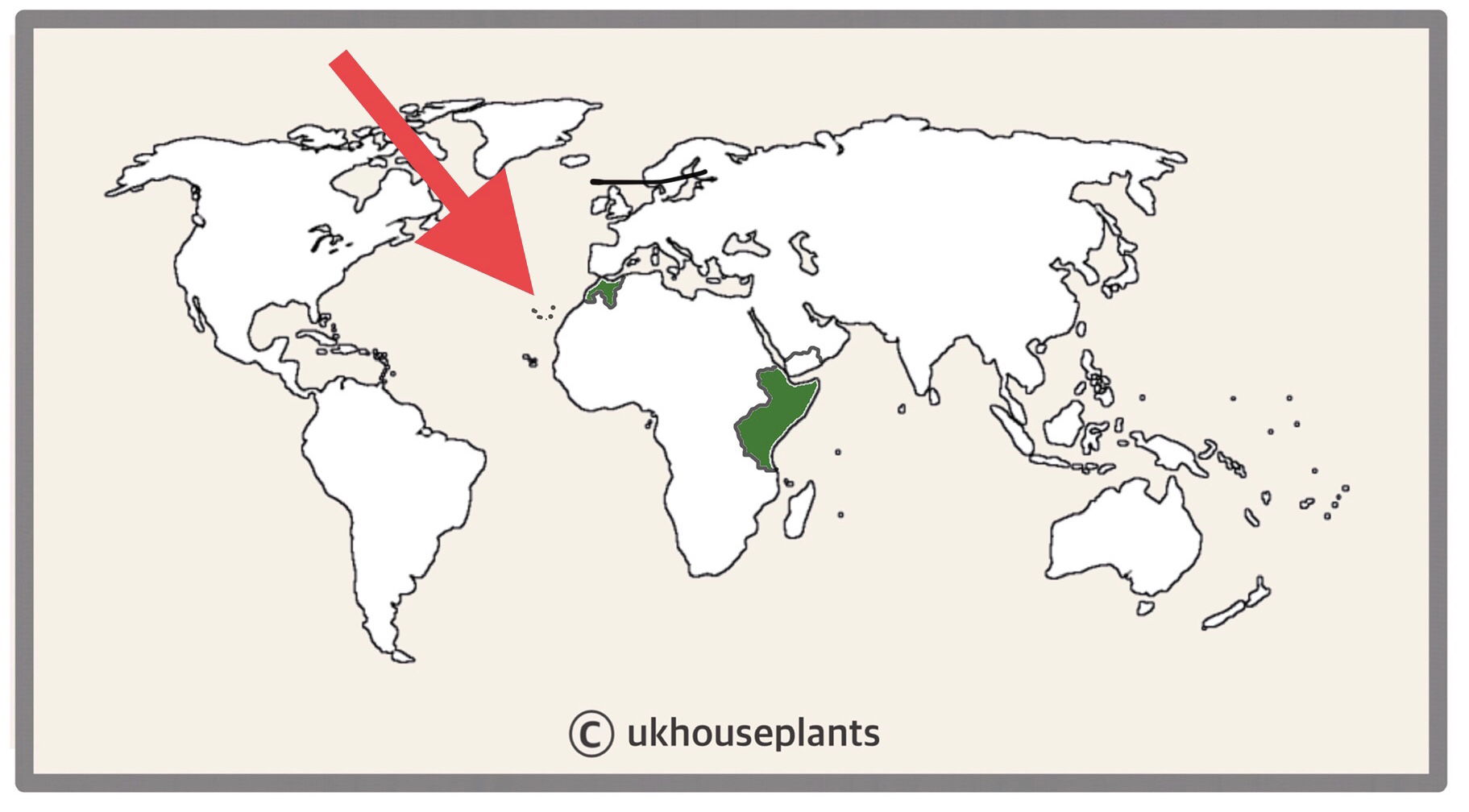 The Distribution of Aeonium in Green & A. arboreum Arrowed (Canary Islands).
The Distribution of Aeonium in Green & A. arboreum Arrowed (Canary Islands).
Temperature
5° - 35°C (40° - 95°F)
H2 (Hardiness Zone 10) - Tolerant of temperatures above freezing. This plant will die if left in temperatures below frosts; move to a conservatory or greenhouse until this risk has elapsed. Aeoniums can also be grown indoors all year round in a sunny windowsill or semi-heated consecratory/greenhouse.
Spread
When grown in containers, most specimens will reach an ultimate height of 0.7m in height and 0.5m in width. At this size, your specimen may begin to flower which will signal the end of its life in some cases (Research 'Monocarpic Plants'). Feel free to take stem cuttings to keep your plant's legacy alive for several more years to come by following the information in the 'Propagation' section below.
Pruning & Maintenance
Remove yellow or dying leaves, and plant debris to encourage better-growing conditions. While pruning, always use clean utensils or shears to reduce the chance of bacterial and fungal diseases. Never cut through yellowed tissue as this may cause further damage in the likes of diseases or bacterial infections. Remember to make clean incisions as too-damaged wounds may shock the plant, causing weakened growth and a decline in health.
Propagation
Via Seed & Stem Cuttings.
Stem Cuttings (Easy) - Prune the top 10cm (4 inches) off from the leading growths, using using sterile scissors or secateurs. Be sure to choose damage-free, the juvenile growth as any cuts and bruises will lead to disease. Place the stems into the water once the roots have grown to around 7cm (3 inches) in length. You can then place the rooted end into the soil, making sure no leaves are submerged. Use a 7cm pot and with a well-draining potting mix, preferably 'Cactus & Succulent' compost, to reduce the risk of over-watering and basal rot. Provide a bright setting with temperatures around 18°C (64°F) with the majority of the soil drying out in between waters. New leaves should emerge within the ten weeks, as long as the soil is kept on the drier to life.
 Placing the stems into clean water for two weeks will ensure root development before being placed in soil. The specimen above will be ready for a pot in another two weeks or so!
Placing the stems into clean water for two weeks will ensure root development before being placed in soil. The specimen above will be ready for a pot in another two weeks or so!
Flowers
Yellow flowers, arranged in conical shapes above the foliage line, will develop across the months of spring and summer, lasting several weeks. Gorgeous flowers may be produced during this time if a good dormancy period from the previous winter is served. Reduce temperatures to around 10°C (50°F) accompanied by little watering to promote the plant to enter this vital stage of the year.
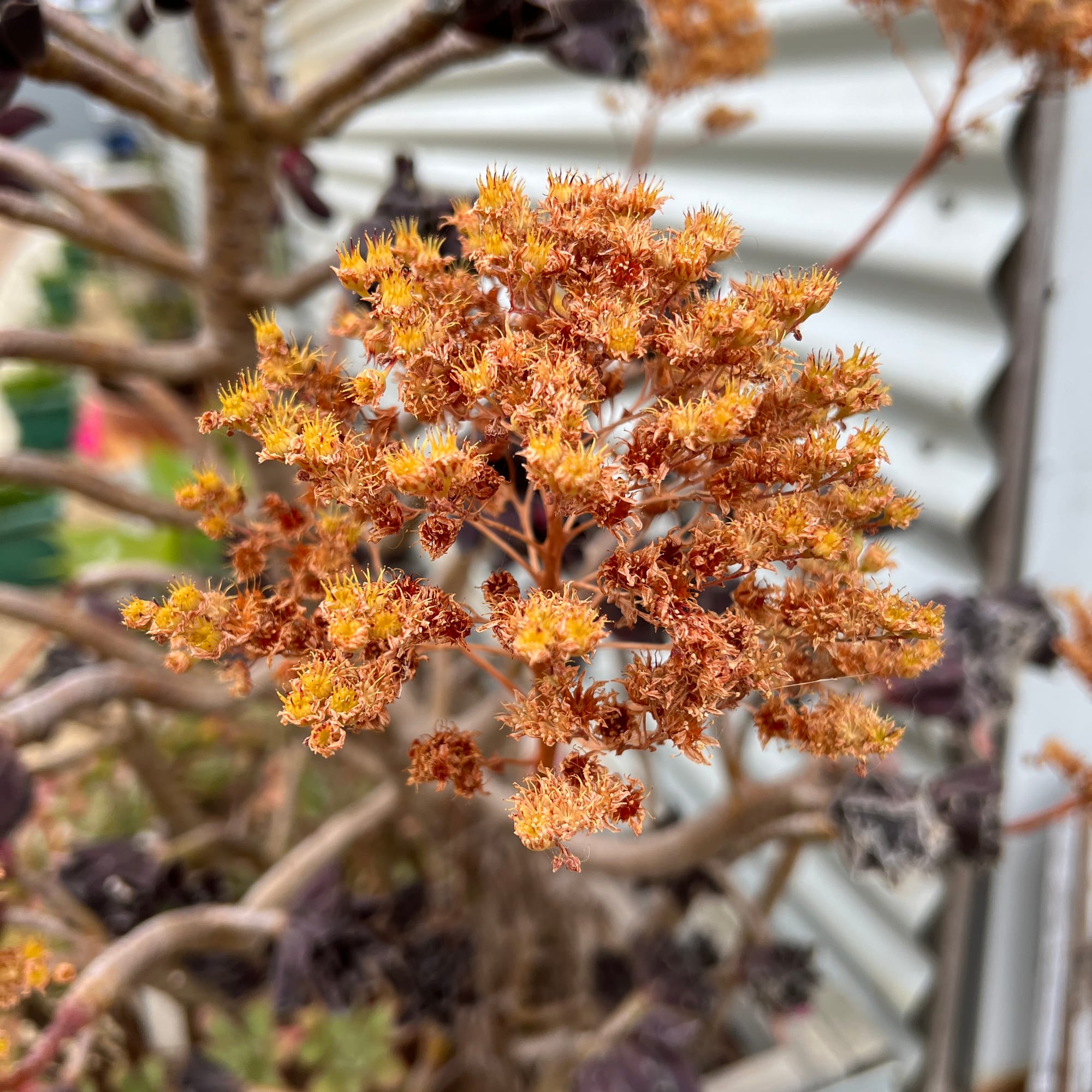 Clusters of yellow flowers will emerge from the tops of each stem once your Aeonium reaches maturity. Each stem terminal will only bloom once, so look out for new growths that emerge from its base. Don't discard the plant!
Clusters of yellow flowers will emerge from the tops of each stem once your Aeonium reaches maturity. Each stem terminal will only bloom once, so look out for new growths that emerge from its base. Don't discard the plant!
Repotting
Repot every three to four years in spring using a 'Cactus & Succulent' labelled potting mix and the next sized pot with adequate drainage. Hydrate the plant 24hrs before the tinkering with the roots to prevent the risk of transplant shock. For those situated in a darker location, introduce an extra amount of perlite and grit into the deeper portion of the pot to downplay over-watering risks. Click on this link for a detailed step-by-step guide on transplantation, or via this link to learn about repotting with root rot.
Book a 1-to-1 video call with Joe Bagley if you'd like a personal guide to repotting your houseplant. This will include recommending the right branded-compost and pot size, followed by a live video call whilst you transplant the specimen for step-by-step guidance and answer any further questions!
Pests & Diseases
Keep an eye out for vine weevils (uncommon indoors), spider mites & mealybugs. For more info on how to address any of these issues, hit this link. Common diseases with Cacti are root, crown or heart rot, sun-scald, soft rot, scabs, nematodes, leaf-spot disease and powdery mildew. Identifying Common Houseplant Diseases & Viruses
Toxicity
Not known to be poisonous when consumed by pets and humans. If large quantities are eaten, it may result in vomiting, nausea and a loss of appetite.
Retail Locations
B&Q, Dobbies, Homebase, Online Stores.
Book a 1-to-1 Call with Joe Bagley
If you need further advice with your houseplants, book an advice call with ukhouseplants' friendly and expert writer today! This can be done via a video or audio call on most apps, including Facebook, FaceTime & Skype. A ten-minute call costs £5.99 (US$7), or £15.99 for thirty minutes. You can ask multiple questions, including queries on plants, pests, terrariums, repotting advice and anything in between. Please consider supporting this service to keep ukhouseplants thriving!